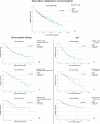Programmable (proSA®) vs. fixed (SHUNTASSISTANT®) gravitational valves in pediatric patients with hydrocephalus: a 16-year retrospective single-center comparative study with biomechanical analysis
- PMID: 37640980
- PMCID: PMC10739459
- DOI: 10.1007/s00701-023-05751-y
Programmable (proSA®) vs. fixed (SHUNTASSISTANT®) gravitational valves in pediatric patients with hydrocephalus: a 16-year retrospective single-center comparative study with biomechanical analysis
Abstract
Purpose: In pediatric hydrocephalus (HC) treatment, programmable gravitational valves offer greater flexibility to manage overdrainage during children's growth. However, it remains unclear whether these devices provide better outcomes rather than their precursors. The study assessed the benefit from programmability of gravitational valve, i.e., programmable-SHUNTASSISTANT (proSA®) vs. SHUNTASSISTANT® (SA®).
Methods: Clinical records and imaging of pediatric patients with hydrocephalus of non-tumoral etiology treated with fixed (SA®) or programmable (proSA®) gravitational valves between January 2006 and January 2022 were analyzed in a retrospective single-center study. Valve survival was compared in relation to age and etiology. Lately explanted valves received biomechanical analysis.
Results: A total of 391 gravitational valves (254 SA® and 137 proSA®) were inserted in 244 patients (n = 134 males). One hundred thirty-three SA® (52.4%) and 67 proSA® (48.9%) were explanted during a follow-up of 81.1 ± 46.3 months. Valve survival rate at 1 and 5 years with proSA® was 87.6% and 60.6% compared to 81.9% and 58.7% with SA®, with mean survival time 56.4 ± 35.01 and 51.4 ± 43.0 months, respectively (P = 0.245). Age < 2 years at implantation correlated with significantly lower valve survival rates (P < 0.001), while HC etiology showed no significant impact. Overdrainage alone accounted for more SA® revisions (39.8% vs. 3.1%, P < 0.001), while dysfunctions of the adjustment system represented the first cause of valve replacement in proSA® cohort (45.3%). The biomechanical analysis performed on 41 proSA® and 31 SA® showed deposits on the valve's internal surface in 97.6% and 90.3% of cases.
Conclusion: Our comparative study between proSA® and SA® valves in pediatric HC demonstrated that both valves showed similar survival rates, regardless of etiology but only with young age at implantation. The programmability may be beneficial in preventing sequelae of chronic overdrainage but does not reduce need for valve revision and proSA® valve should be considered in selected cases in growing children older than 2 years.
Keywords: Gravitational valve; Hydrocephalus; Overdrainage; SHUNTASSISTANT®; Underdrainage; proSA®.
© 2023. The Author(s).
Conflict of interest statement
August von Hardenberg and Christoph Miethke work at Miethke GmbH & Co. KG and supervised the valve analysis. The authors declare no conflict of interest.
Figures




Similar articles
-
The applicability of fixed and adjustable gravitational shunt valves in two different clinical settings.Acta Neurochir (Wien). 2018 Jul;160(7):1415-1423. doi: 10.1007/s00701-018-3568-y. Epub 2018 May 27. Acta Neurochir (Wien). 2018. PMID: 29804178
-
From fixed-pressure paediGAV to programmable proGAV/proSA serial valves for pediatric hydrocephalus within the 1st year of life: a technical single-center analysis.J Neurosurg Pediatr. 2023 Mar 17;31(6):536-544. doi: 10.3171/2023.1.PEDS22341. Print 2023 Jun 1. J Neurosurg Pediatr. 2023. PMID: 36933264
-
PROSAIKA: a prospective multicenter registry with the first programmable gravitational device for hydrocephalus shunting.Clin Neurol Neurosurg. 2015 Oct;137:132-6. doi: 10.1016/j.clineuro.2015.07.002. Epub 2015 Jul 8. Clin Neurol Neurosurg. 2015. PMID: 26196478 Clinical Trial.
-
Management of Slit Ventricle Syndrome: A Single-Center Case Series of 32 Surgically Treated Patients.World Neurosurg. 2022 Feb;158:e352-e361. doi: 10.1016/j.wneu.2021.10.183. Epub 2021 Nov 6. World Neurosurg. 2022. PMID: 34749014 Review.
-
Shunt Devices for the Treatment of Adult Hydrocephalus: Recent Progress and Characteristics.Neurol Med Chir (Tokyo). 2016 May 15;56(5):274-83. doi: 10.2176/nmc.ra.2015-0282. Epub 2016 Apr 4. Neurol Med Chir (Tokyo). 2016. PMID: 27041631 Free PMC article. Review.
References
MeSH terms
LinkOut - more resources
Full Text Sources
Medical

